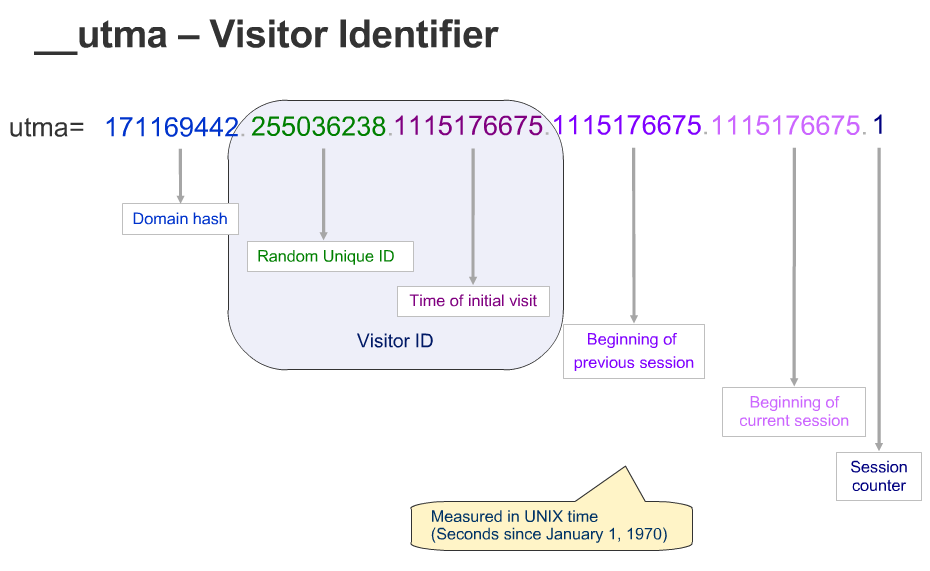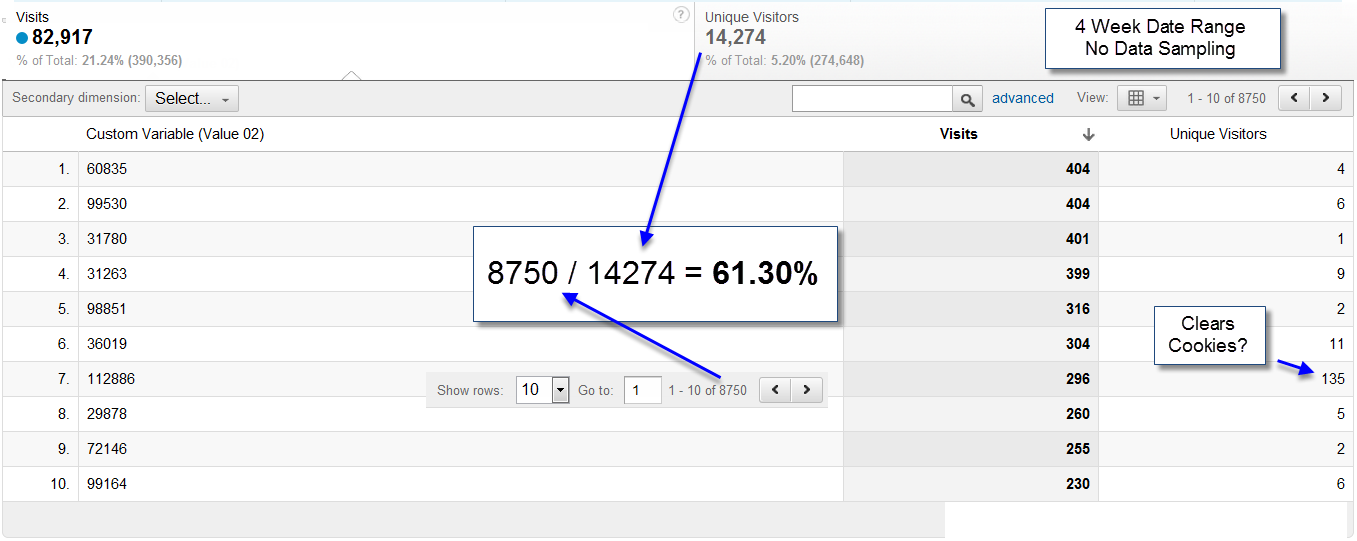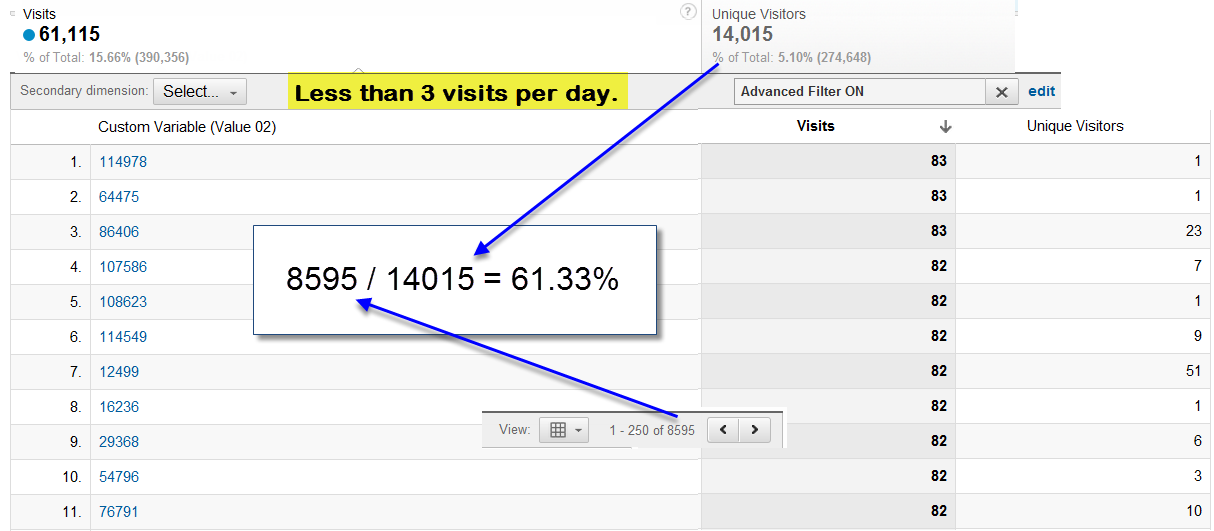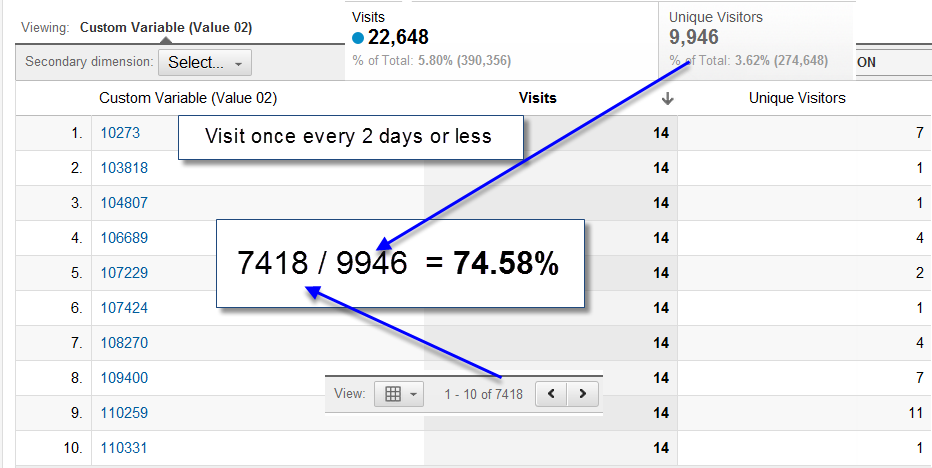“Unique” Visitors 25%-39% inflated
I’ve been working on implementations with a number of clients who have a need for visitor level tracking in Google Analytics so that they can start using GA to measure things like customer loyalty and (try to) calculate Lifetime Customer Value. I understand that there are a number of data models available to approach these sorts of questions, and that either Custom Variables or Events can be used (using either visitor level vars, or session level vars populated from server-side values).
In general, I like pushing the _utma cookie value back into Google Analytics, as it uncovers every single visit in the API. There are lots of benefits to doing this. Justin Cutroni wrote a nice post about merging GA data with a data warehouse. This is just one (powerful) thing that can be done using this method.
What interests me in this post is “how unique are ‘unique’ visitors?” We all know that a unique visitor is nothing more than the value of the _utma cookie’s unique ID. I don’t know about you, but I certainly access websites from multiple browsers from multiple computers. I don’t find it unreasonable for a “person” to indeed have 6 or 7 unique “visitor” values. Start adding in users who clear their cookies and/or Private Browsing and the meaning of “uniques” really begins to degrade.
Luckily, I have access to data where, in addition to capturing _utma values, we’re also capturing obfuscated member ID values. These values are set as a custom variable upon login. This means that a user will maintain their ID whether or not they switch browsers or clear cookies. Here are some of the numbers that I pulled.
The data set that is decently large and no data sampling has been applied to these numbers. At first glance, it appears that the number of unique logins is 61% of the number of GA’s unique visitors. Two things that stuck out at me were the number of visits in a 28 day period by some of the most active users. The top ten most active users average 11.68 visits per day. Also, line 7 had a large ratio of unique visitors to visits. Was this one user who cleared cookies often? Was this shared login information?
In order to make sure that this made sense among users who visited the site less often, I filtered by logins that had less than 3 visits per day, 2 visits per day, and visits once every 2 days. The numbers were pretty consistent for members who came 3 times a day or less, though users who visited once every 2 days or less saw a higher percentage of unique visitors to login IDs.
The Bottom Line:
The “unique visitor” metric was never meant to describe the number of “unique people” that visited a site. Admittedly, this terminology can be confusing for the average person. While web analysts have known that ‘unique visitors’ refers to a count of unique cookie values in the browser, I find it quite nice to be able to quantify this in numbers. Indeed, from the data above, it appears that the number of unique visitors reported is somewhere between 25% – 39% greater than the number of people who visit a site. If you have any additional data, please feel free to share below.





Unique is unique.
Great article. Thanks for sharing! I would still like to know what is the difference in google analytics between unique visitors and visits.
Olivia
http://0liviaschoice.blogspot.com
My pages has 500 unique visitors a day en google analytics but onle 10 en web-stat??
biocosmeticas
Just saw this for the first time but realized it’s nearly 2 years old minus 3 months. Knowing GA has made changes since then is this post still accurate?
The latest official methodology is described at https://support.google.com/analytics/answer/2992042?hl=en,
in which “Calculation #2” is based on the __utma cookie (still?)
Yes, this is still accurate for ga.js
That’s pretty crazy. You say the “data set that is decently large”…how large? What kind of site is the data from?
I’d think it would greatly vary depending on type/industry. I would think only a small % of techies and digital marketers would count as numerous unique visitors.
People may visit from work and from home but that would be for sites such social media, news, email, etc.
Otherwise, most people have a preferred browser, don’t delete cookies (or even know how or what they are or like my wife), and even if using incognito mode or Private Browsing would keep windows open for a long time never shutting down and just letting the computer sleep until the next day.
Inflation of 25% – 39% seems high unless for those certain types of sites. But I can’t argue w/ your data set, even if just 1 example.
Nice article. Analytics are always a surprise!
Really nice, appreciate your efforts. Thanks for providing clarity over this issue 🙂
http://www.markvilla.com … try it frnds. its amazing
interesting, thanks for writing it up
That is pretty insane. You state the “data set that is sufficiently huge”… how enormous? What sort of site is the data from?
I’d figure it would incredibly shift contingent upon type/industry. I would think just a little % of geeks and computerized advertisers would consider various remarkable guests.
Individuals may visit from work and from home however that would be for destinations such web-based media, news, email, and so on
Something else, a great many people have a favored program, don’t erase treats (or even expertise or what they are or like my significant other), and regardless of whether utilizing undercover mode or Private Browsing would keep windows open for quite a while failing to shut down and simply letting the PC rest until the following day.